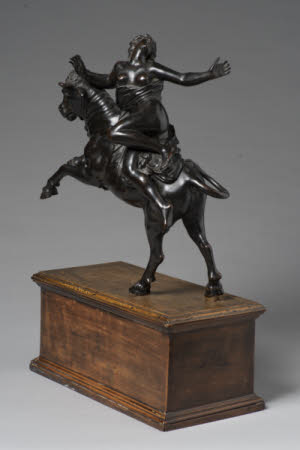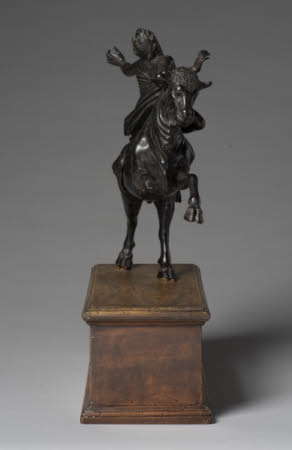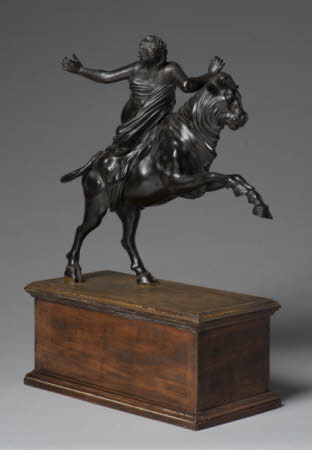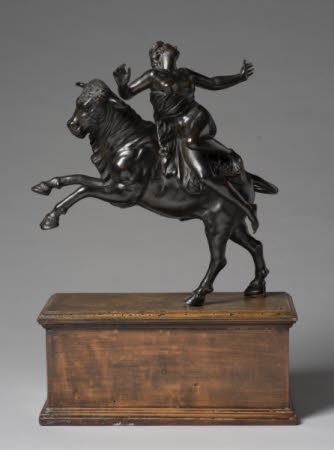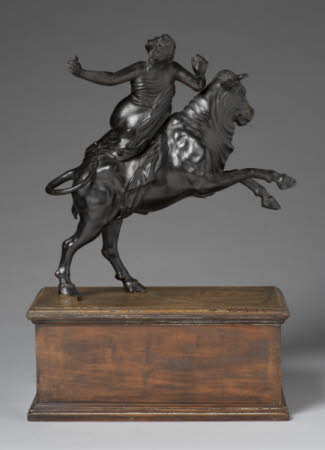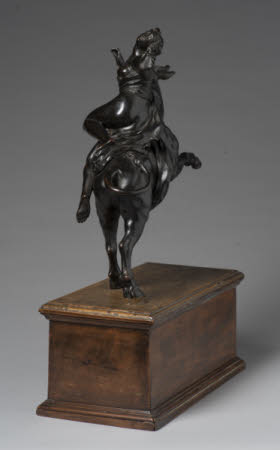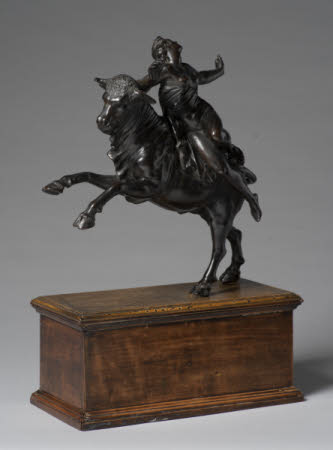The abduction of Europa by Jupiter disguised as a bull
after Giovanni Francesco Susini (Florence 1585- Florence 1653)
Category
Art / Sculpture
Date
1650 - 1700
Materials
Bronze with black lacquer
Measurements
33 x 31 mm
Place of origin
Italy
Order this imageCollection
Ickworth, Suffolk
NT 850843
Summary
Sculpture, bronze; Europe and the Bull; Italy, Florence, after a model attributed to Giovanni Francesco Susini; c. 1650-1700. The bronze depicts the daughter of the king of the city of Tyre, Europa, with whom the king of the gods Jupiter fell in love. He adopted the subterfuge of appearing to Europa in the guise of a white bull, then carrying the girl off on his back across the seas to the island of Crete. The model was invented by the Florentine sculptor Giovanni Francesco Susini (1585-c. 1653), a follower of the sculptor Giovanni Bologna (Giambologna, 1529-1608). This is one of several later versions made in unknown Italian foundries.
Full description
A bronze group depicting a young woman, Europa, as she is abducted by the god Jupiter in the form of a leaping bull. Europa is naked except for a drapery that is wrapped round her midriff and spills out over the back of the bull, to provide a sort of blanket on which the woman precariously balances, her arms and hands stretched out whilst she looks upwards pleadingly. Mounted on a rectangular wooden base. The story of the abduction of Europa is one of many in the Greek legends that recount the loves of Jupiter (Greek: Zeus), king of the gods, and the unscrupulous methods he would use in order to achieve his ends with the young women and men who caught his eye. The story was recounted in the Roman poet Ovid’s Metamorphoses (2: 836-75). The daughter of Agenor, king of the coastal city of Tyre in today's Lebanon, Europa was accustomed to go with other girls from the city to pass the time on the seashore. Having instructed Mercury to drive the royal herd of cattle from the mountains of Sidon to the shore at Tyre, Jupiter transformed himself into a magnificent and beautiful white bull and then mingled with the herd. Europa marvelled at the bull’s beauty and gentleness, plucking up the courage to wind a chain of flowers around the horns of the bull. Eventually she was so taken in by the animal’s friendly gentleness that she mounted his back and began to ride the bull along the beach, but he suddenly started to go faster, plunging into the waves and away from the shore, bearing the now terrified Europa out to sea. It was when they reached the island of Crete that Jupiter shed his disguise and stood revealed before Europa. Once in Crete she would have three sons fathered by Jupiter, Minos, Rhadamanthus and Sarpedon, two of whom would be kings of the island. The composition has traditionally been associated with the Italo-Flemish sculptor Giovanni Bologna (Giambologna, 1529-1608), who made a marble relief of the subject on his Oceanus Fountain in the Boboli Gardens in Florence, completed by Giambologna in 1576 (Berlin 1988, p.99, fig.104). The sculpture certainly has reminiscences of Giambologna’s famous bronze group of the abduction of Deianira, wife of Hercules by the centaur Nessus (example at Sudbury, NT 652912; see also Avery and Radcliffe 1978, nos. 60-67) and indeed does seem to have been created as a form of pendant to this model. In 1956, Elisabeth Dhanens did attribute the model to Giambologna himself, but there is no documentary evidence for this and most more recent scholars have rejected the notion that he was responsible for the design. The model seems in fact to have originated with one of Giambologna’s followers, the Florentine sculptor Giovanni Francesco Susini (1585-c. 1653), to whom a superb cast that first appeared on the market in 2006 has been attributed (Charles Avery in Tomasso 2008, no. 17). This version stands head and shoulders above other known casts, which include the Ickworth bronze but also examples in the Museo Nazionale del Bargello, Florence (Berlin 1988, p. 104, fig. 110) and the Museo del Palazzo di Venezia, Rome (Inv. 9285; Cannata 2011, no. 94). All of these are relatively poor casts, especially when compared with the example formerly with Tomasso Brothers, which is of outstanding quality and in excellent condition, with its red lacquer largely intact. Major differences between the Tomasso and Ickworth bronzes include the bull’s poll, which in the former is decorated with flowers as described by Ovid in the Metamorphoses, but no flowers are to be seen in the Ickworth bronze. In the Tomasso version Europa holds on the bull’s right horn, again as described by Ovid, whereas in the Ickworth and other versions both arms and hands flail wildly in the air. Finally, the head and hair of Europa in the Ickworth version are conventionally and somewhat blandly modelled, whereas in the version with Tomasso her face is stricken and her hair streams out wildly, a stylistic feature that helps point to Susini as the inventor of the model. Europa and the Bull became quite a popular theme in bronze sculpture in the later seventeenth and the eighteenth centuries, in France and in Italy (see Berlin 1988, pp.101-05), including a version by the Florentine sculptor Giovanni Battista Foggini (1652-1715) in the Fitzwilliam Museum, Cambridge (Avery 2002, no. 7). The Ickworth group is very unlikely to have been made in Giovanni Francesco Susini’s workshop and may not even be Florentine, but was probably, along with other secondary versions, made in Italy some time in the later seventeenth century. Jeremy Warren October 2025
Provenance
Probably acquired by Frederick Augustus Hervey, 4th Earl of Bristol and Bishop of Derry (1730-1803); by descent to Rear Admiral Frederick William Fane Hervey, 4th Marquess of Bristol (1863-1951), on whose death valued for probate; accepted in lieu of tax by HM Treasury, and transferred to the National Trust in 1956
Makers and roles
after Giovanni Francesco Susini (Florence 1585- Florence 1653), sculptor after Giambologna (Douai 1529 - Florence 1608), sculptor after Antonio Susini (fl.Florence 1572 – d.Florence 1624), sculptor
References
Avery and Radcliffe 1978: Charles Avery and Anthony Radcliffe, Giambologna, 1529-1608: sculptor to the Medici, exh.cat. venues: Royal Scottish Museum, Edinburgh, Victoria & Albert Museum, London, Kunsthistorisches Museum, Vienna 1978, p. 117, no. 68 Dhanens 1956: Elisabeth Dhanens, Jean Boulogne. Giovanni Bologna Fiammingo Douai 1529-Florence 1608, Brussels 1956, p. 203, no. 38, afb. 127. Avery 1987: Charles Avery, Giambologna, The Complete Sculpture, Oxford 1987, p. 264, no. 94, Pl. 306 Berlin 1988: Die Verführung der Europa, exh.cat. Kunstgewerbemuseum, Berlin 1988 Avery 2002: Victoria Avery, Renaissance and Baroque Bronzes from the Fitzwilliam Museum, Cambridge, exh. cat. Daniel Katz Gallery, London 2002 Tomasso Brothers 2008: Scultura. Tomasso Brothers Fine Art, London 2008, no. 17 Cannata 2011: Pietro Cannata, Museo Nazionale del Palazzo di Venezia. Sculture in Bronzo (Roma. Il Palazzo di Venezia e le sue collezioni di scultura, III), Rome 2011
